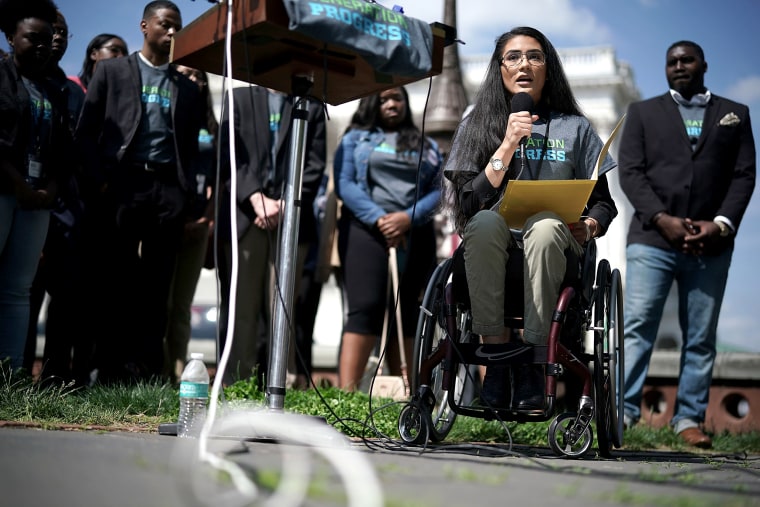Karina Sartiaguin has been commemorating her “second birthday” on Dec. 6 each year, ever since a bullet paralyzed her from the waist down in 2010.
“I feel like I probably wouldn't think about the day so often if I wouldn’t be living with that outcome,” she told NBC News. “I have to wake up and see my wheelchair, or move myself in my wheelchair. And I’m reminded of that day every day.”
Sartiaguin was 16 years old, hanging out with friends, when she became the victim of a drive-by shooting outside her high school in Aurora, Colorado. After she was hit, she lay motionless in the street, drifting in and out of consciousness. She eventually awoke in the emergency room to her clothes being cut off, and as she struggled to breathe or talk, it became clear that her lung had been punctured.
“Honestly, I think that that was probably the worst part about getting shot, is just the 'trying to save me' part,” Sartiaguin said.
While more than 100 people in the United States die each day from gun violence, more than 230 people a day experience a nonfatal — and like Sartiaguin, sometimes life-altering — gun injury.
According to a new report Everytown for Gun Safety shared exclusively with NBC News, gunshots wounded an estimated 84,776 people in 2017, many of them teenagers and young adults from Black and brown communities. Yet, "there is no centralized system for tracking nonfatal firearm injuries and no place to look up the number, type and location of these injuries as a basis to analyze the data and use it to shape effective responses," the report states, a gap Everytown's research tries to fill.
Latinos are hospitalized for nonfatal gun injuries at more than double the rate, and Black patients at more than 10 times the rate, of their white counterparts, the Everytown analysis found.
On a more granular level, Latinos and Black people suffer nonfatal firearm assaults — shootings that weren’t self-harm or unintentional — at exponentially higher rates than white people. A majority of gun assault survivors live in big cities, and 6 in 10 reside in ZIP codes with a median household income of less than $44,000 per year.
Black and Latino young men are particularly affected “partly because of generations of institutional neglect,” Sarah Burd-Sharps, director of research at Everytown, told NBC News.
“For most of these survivors, the long-term repercussions do not end when they leave the hospital,” Burd-Sharps wrote in the report. “The road to recovery can be long, the financial costs can be high, and the psychological and emotional toll can be debilitating, even for minor injuries.”
Over a third of gunshot wound victims treated at hospitals are between 15 and 24 years old, while the vast majority are men and boys.
“One of the strongest predictors of future violence, particularly for young people, is surviving,” Burd-Sharps said. “So if we’re not counting, and understanding, you know, and supporting people who are shot and survive, we are going to make no progress in terms of disrupting future cycles of violence.”
Caterina Roman, a professor of criminal justice at Temple University, says that when you look at urban communities that tend toward the highest levels of violence, "it’s the communities that have been the most disadvantaged, and where you have high levels of disinvestment and racism that come together to create the lack of opportunity for youth and young adults to have productive lives."
Investments in housing, education, the arts and recreation, physical infrastructure and child welfare could reduce violence long-term, she suggested, and positive social interactions are essential.
“It is imperative that we take a deep look at all these macro-level, these structural factors that come together related to disinvestment," Roman said, "that have created the lack of opportunity in these neighborhoods.”
More outreach and hospital-based programs
To curtail firearm injuries, Everytown’s report recommends further research, gun safety policies and local outreach.
Hospital-based violence intervention programs are especially important, Burd-Sharps said, to help young people process their trauma and access whatever resources they need.
Ten years ago, Sartiaguin awoke in the ICU, confused, wearing chest and neck braces and hooked up to IVs. She languished in hospitals for around two months, as medical professionals used “doctor terms” to explain why she wouldn’t be able to walk anymore.
Even after she was discharged, she wasn’t in the right mindset to be surrounded by other teens and never finished her high school degree. Her family has had to completely change how they live and travel, and it’s sometimes been difficult to find work, she said, because of stigma around disabilities.
Then, there are the more visceral losses, like that tired feeling she once used to experience after going on a run.
“Even till this day, there’s still things that I struggle with,” she said. “Because I kind of know what I’m missing.”
Follow NBC Latino on Facebook, Twitter and Instagram.
